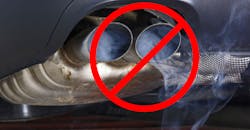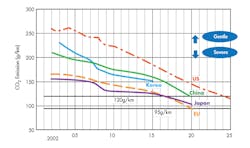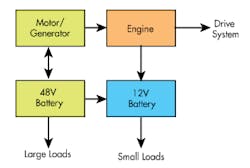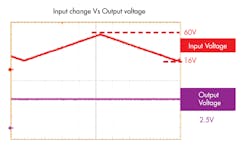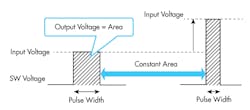Mild Hybrid EVs Accelerating the Development of Automotive-Graded DC/DC Converters
While countries are trying to achieve CO2 levels mandated by governments, the production of mild hybrid electric vehicles (EVs) is expected to increase from 1.3M to 7.1M by 2024. For example, the EU is planning to achieve 95 g/km of CO2 by 2020, China is planning to achieve 120 g/km of CO2, and the United States is expecting to achieve 100g/km by 2025. Mild hybrid EVs can help reduce CO2 emissions because they are more efficient, environmentally friendly, and can also improve fuel economy.
Reduce CO2 emissions and increase fuel economy mandated by governments. (Figure courtesy of Rohm)
A mild hybrid EV (MHEV) contains a 12V battery and a 48V battery). The 48V battery can supply power to heavy loads such as the air conditioning and electric power steering, and it can also supply power to the 12V battery and small load through a dc/dc converter. An MHEV contains an electric motor generator that is also connected to the engine of the vehicle. The electric motor generator can supply power to the engine and it can also receive power from the engine from a generating breaking system.
MHEV (48V+12V) system can supply power to large and small loads. (Figure courtesy of Rohm)
The 48V lithium-ion (Li-ion) battery in a mild hybrid EV provides better regenerative energy efficiency and it can also reduce power losses and current consumption benefiting large loads like air conditioning, electric power steering, etc. A 48V -3.3V power conversion can be done typically using a two-stage conversion but with a single dc/dc conversion, it is possible to reduce the number of components and the size of the PCB area, consequently reducing the cost of the design.
Rohm has just announced the BD9V100MUF-C, a new power supply IC especially for automotive battery-powered supplies. This synchronous buck converter enables direct conversion from 60Vin to 3.3/5Voutput at 2 MHz (this frequency was used to be outside the AM radio bandwidth). But operating the device at high input voltage and high frequency comes with challenges such as noise and delayed turn-on. Turning on and off a switch is challenging because there is a lot of ringing from parasitic inductance and capacitance resonance in the circuit board.
The output voltage is constant while the input voltage varies (16V-60V) at 2MHX. (Figure courtesy of Rohm)
Rohm’s designers solved these challenges by sensing the inductor current when the high-side switch is off by using a high-speed pulse control technology. This enables stable voltage control even with extremely short switching ON time. To obtain a constant output voltage from high input voltage, a small switch pulse width is used to help maintain the same amount of energy. If the input voltage increases, the switch pulse width narrows regulate the output voltage by maintaining a constant area (energy).
The input voltage affects the pulse width in a dc/dc converter. (Figure courtesy of Rohm)
The BD9V100MUF-C is able to operate with a typical pulse width value of 9ns and a maximum value of 20ns at 2MHz. For example, the pulse width needed for a 2.5V output at 2MHz is:
Pulse Width = 2.5V ÷ 60V × 500ns = 20.8ns
The BD9V100MUF-C comes in a QFN package with wettable flank that allows customers to do automatic optical inspections and it will go into mass production in December 2017. In the future, Rohm will develop an industrial buck (scheduled for release next year) and a boost-buck and a PMIC. With the steady growth of the mild hybrid EV( 48V + 12V) market, more automotive-graded power solutions will emerge, giving automotive OEMs more opportunities to build much more efficient MHEVs.
About the Author
Maria Guerra
Power/Analog Editor
Maria Guerra is the Power/Analog Editor for Electronic Design. She is an Electrical Engineer with an MSEE from NYU Tandon School of Engineering. She has a very solid engineering background and extensive experience with technical documentation and writing. Before joining Electronic Design, she was an Electrical Engineer for Kellogg, Brown & Root Ltd (London. U.K.). During her years in the Oil and Gas Industry she was involved in a range of projects for both offshore and onshore designs. Her technical and soft skills bring a practical, hands-on approach to the Electronic Design team.
